Trigger Point Therapy for Myofascial Pain (20 page)
Read Trigger Point Therapy for Myofascial Pain Online
Authors: L.M.T. L.Ac. Donna Finando

The powerful biceps brachii can be palpated throughout its course. Flex the arm 15 to 45 degrees to locate the tendon of attachment on the (bicipital) tuberosity of the radius. Palpate biceps brachii, moving superiorly. The long head can be palpated by following its tendon of attachment as it passes through the bicipital groove. External rotation of the arm facilitates the ability to palpate the tendon within its groove. The short head can be palpated as it moves medially toward its attachment at the coracoid process of the scapula.
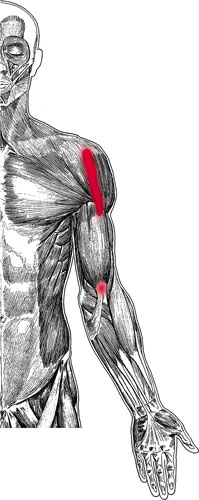
Biceps brachii pain pattern
Pain pattern:
Superficial aching pain in the anterior shoulder and arm, with some restriction of motion.
Causative or perpetuating factors:
Sustained elbow flexion; chronic or acute strain caused by sports or heavy lifting.
Satellite trigger points:
Brachialis, supinator, triceps brachii.
Affected organ system:
Respiratory system.
Associated zones, meridians, and points:
Ventral zone; Hand Tai Yin Lung meridian, Hand Jue Yin Pericardium meridian; LU 3,4, and 5; PC 2 and 3.
Stretch exercise:
Hold on to a doorjamb with the affected arm. The hand should be at shoulder level with the elbow straight and the thumb pointing toward the floor. Turn the body away from the arm without allowing any joint to bend. Hold this position for a count of fifteen to twenty.
Strengthening exercise:
Stand with the arms at your sides, palms facing toward the body. Flex the forearms and, keeping the elbows close to the body, draw the palms toward the shoulder. Slowly return to the starting position. Flex to a count of two; release to a count of four.
Now stand with the arms at your sides, this time with palms facing outward. Flex the forearms and, keeping the elbows close to the body, draw the palms toward the shoulder. Slowly return to the starting position. Flex to a count of two; release to a count of four.
Repeat both exercises eight to ten times, increasing repetitions as strength allows. Hand weights may be used to increase the work effort placed on the muscle.
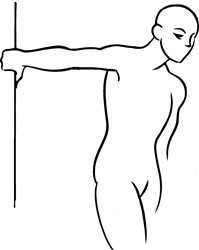
Stretch exercise: Biceps brachii
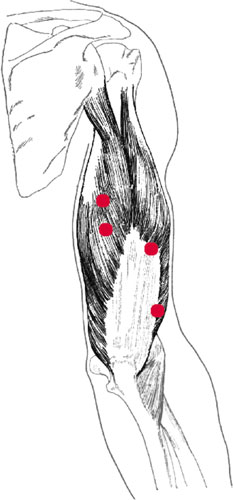
Triceps brachii and trigger points
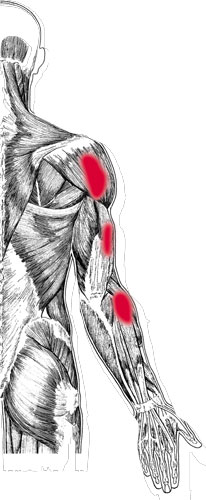
Triceps brachii pain pattern
T
RICEPS
B
RACHII
Proximal attachment:
Long head:
infraglenoid lip of the scapula.
Lateral head:
posterior humerus, superior to the radial groove.
Medial head:
posterior humerus, inferior to the radial groove.
Distal attachment:
Via a common tendon to the olecranon process of the ulna.
Action:
Extension of the forearm at the elbow.
Long head:
aids in extension and adduction of the arm at the shoulder.
Palpation:
To locate triceps brachii, identify the following structures:
- Head of the humerus
- Olecranon process of the ulnaâLarge process at the proximal end of the ulna
Palpate the triceps muscle throughout its course, moving from the olecranon process proximally along the posterior humerus. Palpate the long head to its attachment on the scapula, then return to the body of the muscle where it forms a common muscular belly with the lateral head. The medial head lies deep to the long head, but it can be palpated at the distal aspect of the medial humerus. Palpate both the posterolateral and the posteromedial aspects of the arm for taut bands and areas of constriction within the body of the muscle.
Pain pattern:
Pain throughout the posterior aspect of the arm, including the lateral epicondyle. Pain may be experienced in the fourth and fifth digits and/or the suprascapular region. If constrictions or trigger points are located in the long head, the patient may be unable to straighten his arm against his ear while holding the arm up above his head.
Causative or perpetuating factors:
Overload stresses associated with pushing heavy objects or with rapid extension of the forearm.
Satellite trigger points:
Latissimus dorsi, teres major, teres minor, anconeus, supinator, brachioradialis, extensor carpi radialis.
Affected organ system:
Digestive system.
Associated zones, meridians, and points:
Dorsal zone; Hand Shao Yang Triple Warmer meridian; TW 10â13.
Stretch exercise:
Place the palm of the hand of the affected arm on the spine of the homolateral scapula. Draw the elbow toward the ear and back behind the head. Gentle posterior pressure to the region proximal to the elbow will increase the stretch. Hold this position for a count of ten to fifteen.
Strengthening exercise:
Stand or sit in a comfortable position. Place the hand near the spine of the homolateral scapula, drawing the elbow toward the ear. Without moving the upper arm, extend the elbow, straightening the arm. Extend to a count of two; return to the starting position to a count of four.
Repeat eight to ten times, increasing repetitions as strength of the muscle allows. Hand weights may be used to increase the work effort of the muscle.
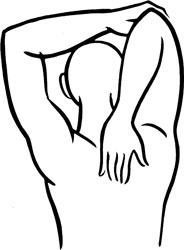
Stretch exercise:Triceps brachii
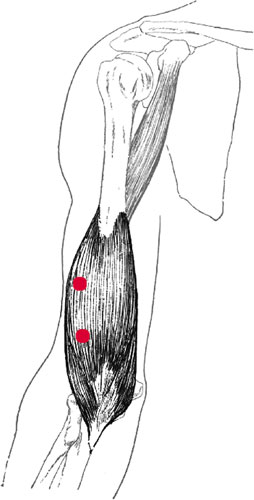
Brachialis and trigger points
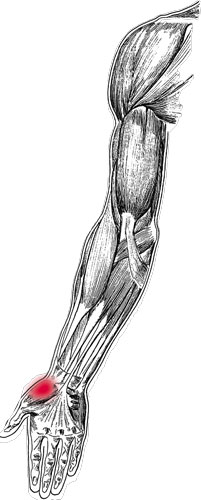
Brachialis pain pattern
B
RACHIALIS
Proximal attachment:
Distal one-half of the shaft of the anterior humerus.
Distal attachment:
Coronoid process of the ulna.
Action:
Flexion of the forearm at the elbow.
Palpation:
Because of its placement on the anterior aspects of the humerus and ulna, the brachialis is the primary flexor of the forearm.
To locate brachialis, identify the following structure:
- Biceps brachiiâSee muscle description on page 111.
To palpate brachialis, supinate the patient's arm. Flex the arm approximately 30 degrees and move the bulk of biceps brachii medially, using the pads of the fingers. Press deep to the displaced biceps to palpate brachialis on the distal one-third of the humerus.
Pain pattern:
Pain and tenderness at the base of the thumb.
Causative or perpetuating factors:
Lifting heavy objects with a bent elbow.
Satellite trigger points:
Brachioradialis, biceps brachii.
Affected organ systems:
Respiratory and cardiovascular systems.
Associated zones, meridians, and points:
Ventral zone; Hand Tai Yin Lung meridian, Hand Jue Yin Pericardium meridian, Hand Shao Yin Heart meridian; LU 5, PC 3, HE 3.
Stretch exercise:
Hyperextend the supinated arm, fully extending the hand and fingers to increase the stretch of the forearm. Placement of the hand beside the seated body, with the palm down and fingers pointing back, will markedly increase the stretch. Hold this position for a count of ten to fifteen.
Strengthening exercise:
Stand with the arms at the sides, palms facing outward. Flex the forearms and, keeping the elbows close to the body, draw the palms toward the shoulder. Slowly return to the starting position. Flex to a count of two; release to a count of four.
Repeat eight to ten times, increasing repetitions as strength allows. Hand weights may be used to increase the work effort placed on the muscle.
